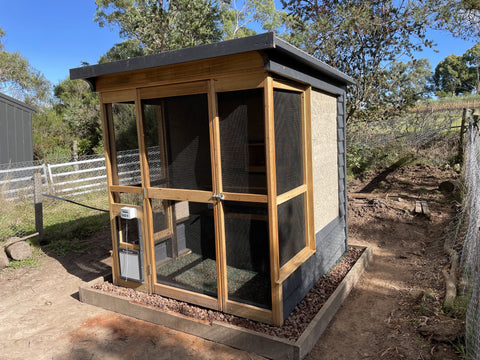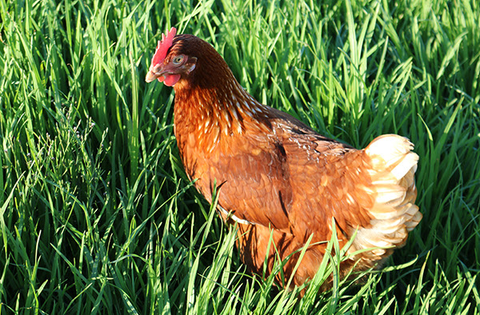When it comes to buying, building, or modifying a chicken coop for your backyard, there are numerous factors to consider. In this post, we share valuable insights gathered from our extensive experience of interacting with backyard chicken enthusiasts over the past decade. Drawing from best practices in poultry-keeping and disease prevention, we provide practical information to guide you. Moreover, we address prevalent myths and misconceptions surrounding chicken coops, separating fact from fiction to ensure you make informed decisions for your flock.
This post is based on our first Winter Series Presentation done on Sunday the 19th of June, 2022 with the video available here or at the conclusion of this post.
Firstly, I’d like to define a couple of key terms:
A chicken coop is the fully enclosed “house” for hens to be dry, safe and warm in.
A chicken run is an “enclosure” that connects to or encapsulates the chicken coop.
Legal responsibilities – how many chickens can you keep?
Most councils in Victoria require that coops and runs are positioned at least 1.5 metres from any boundary, are kept clean and rodent-free, and must not cause any annoyance to neighbours. Chicken feed must be stored in a rodent-proof receptacle and chicken manure must not be allowed to build up and cause offence to neighbours.
The following chart shows the maximum number of hens you can keep for your sized property on the Mornington Peninsula BEFORE needing to apply for a permit:
|
Chickens |
<499 s/mtrs |
500 - 1,199 s/mtrs |
1,200 - 2,499 s/mtrs |
2,500 4,999 s/mtrs |
>5,000 s/mtrs |
>10,000 s/mtrs |
|---|---|---|---|---|---|---|
|
Rooster |
0 |
0 |
0 |
0 |
0 |
0 |
|
Poultry/Fowl or similar |
0 |
5 |
10 |
10 |
10 |
20 |
https://www.mornpen.vic.gov.au/Your-Property/Animals-Pets/How-many-animals-or-birds-can-I-keep-on-my-property
How much room for your flock?
Inside the chicken coop, you should allow 1⁄4 of a square metre per hen. This is actually quite a lot of room as hens will only tend to be inside for sleeping and laying eggs. They love to pack in together at night so a large amount of space is not needed. I like to allow around 1 square metre per hen for the chicken run. This provides each hen with plenty of room to scratch around in, sunbathe, and dust bathe.
Locating your chicken coop
Locate your coop in a well-drained area as we do not want water flowing into it. Build up the area with rocks or scoria if needed. It’s a good idea to have some weather protection from the prevailing wind to avoid driving rain from entering the run. You might be able to position your coop close to a weather barrier such as a fence, trees or a wall. If this isn’t possible, a permanent weatherproof cladding or a roll-down/roll-up blind on one or two sides of your run may work well.
Coop and run bases
Ideally, the base that both the coop and run sit on is concrete but a layer of concrete pavers can also do. Another alternative is to use rock or scoria with a narrow diameter galvanised chicken/aviary mesh on top to stop burrowing pests and predators from entering.
Internal coop environment
The coop should be completely dry with no drafts and just one main door for the hens to enter and exit. There should be ventilation at the top, apex of the coop to reduce the build-up of ammonia from the droppings. A droppings tray at the bottom of the coop should have a layer of wood shavings on it to absorb moisture from droppings and start the composting process. If not using a droppings tray, use a 100 mm deep layer of wood shavings. Avoid the common advice to use hay or straw as it is a poor absorber of droppings and the tubular fibre is a great hiding place for insects such as parasites.
Nest boxes
A single nest box is fine for up to 7-hens but most coops have two. They should be around the size of an A3 piece of paper, which is quite sufficient for the vast majority of chicken breeds. Nests should be cosy and dark with a single open side that has a 100 mm lip on it to contain the nesting material. Nesting material is ideally hemp fibre due to its superior absorbency and natural antibacterial qualities but wood shavings are another option. A curtain made from canvas or an old shirt with a 50 mm gap is ideal and enables hens to feel safe and secure when inside. Never allow hens to sleep in their nest boxes as they will do ⅓ of their droppings at night time, which then ends up on your eggs!
Chicken run environment
Your chicken run should be completely covered by a waterproof roof with 200 mm eaves. A 100 mm layer of wood shavings is ideal to absorb and break down any droppings into compost. Skirting boards of around 200 mm in height at the bottom perimeter work well to contain shavings and reduce drafts, scares, and water ingress while still enabling owners to see the flock.
Pest and predator protection
Ideally, I like all surfaces of the chicken run to be covered in aviary mesh. This means that foxes cannot enter the run, along with pests such as rodents and wild birds. Keeping pests out greatly reduces the risk of parasites and diseases affecting your flock. An automated door is a great way of allowing the flock to exit and enter the run when you want them to free-range in your backyard.
Coop assessment
Locally-made coops are typically built using treated pine and are quite robust. They are not all made equal, though, and many of the details mentioned above can be missing. Imported coops are relatively cheaper when compared with local coops but they tend to be a lot smaller and use low-grade wood and fixings. Imported coops can be a good place to start but they don’t tend to last long in the harsh Australian environment and are easily damaged and entered by predators and pests. Both local and imported coops often need alterations and additions and a good awareness of their limitations.
Myths and misconceptions
Myth: You need a dirt floor for the run so that hens can scratch around.
Fact: Hens are quite happy dust bathing and digging through wood shavings. Droppings that land on dirt won’t compost quickly, so they attract flies and smell a lot! Droppings containing parasitic worms and pathogens such as Salmonella are easily distributed to other flock members by hens stepping in them and spreading them.
Myth: Chicken runs don’t need to be covered or waterproof.
Fact: Dampness supports pathogens and chooks will dig into the dirt to create holes that fill with water when it rains. They will then happily drink the water which quickly becomes contaminated with their fresh droppings and built-up manure. It also isn’t possible to use wood shavings in a wet environment as it negates their ability in converting the droppings into compost. This means that manure builds up along with ammonia levels, pathogen and parasite loads.
Myth: Chicken runs need to be large with plenty of space.
Fact: The larger the run, the larger the volume of materials needed to build it! You also need to cover it to be waterproof and add shavings to get the dropping composting efficiently. Chickens are flock birds that like to congregate together and the area where they have the greatest space should be outside the coop when free-ranging. Deciding when and where to allow free-ranging can then be managed intelligently depending on ground cover, seasonal conditions, and the like.
Myth: You need to have one nest box for each hen in the flock.
Fact: Chickens are flock animals, which means they love doing everything together – including where they lay. They lay at different times which means that only a single next box is needed for up to 7 hens.
Myth: Foxes don’t come out during the day so a run without a roof is fine.
Fact: Foxes absolutely DO come out during the daytime and are excellent climbers. This means that your flock won’t be safe if contained in a chicken run without a roof.
Myth: A tree branch is best to use as perches in the coop.
Fact: Tree branches will vary in size along their length and can contain bends and nodules. This variation can cause discomfort and uneven pressure on the chicken’s foot pad, increasing the risk of foot issues/damage. Many tree branches are happy habitats for red mites as well, which live in the wood and will happily hop straight onto the hens.
Having an understanding of what chickens need to stay safe and healthy in their coop and run is vital in constructing a home for them that works in harmony with their needs. Now that you have been armed with the right information, you will now be in a position to confidently construct, alter, or purchase your own backyard chicken coop and run. Having the right setup will save you a lot of money and time and result in a happier and healthier flock of chickens.







Comments (2)
Thank you for this thought provoking article, there is so much information on the web and I tend to want as much as possible but then get confused so an easy to understand article like this is a godsend so thanks again and best regards Keith
Thanks